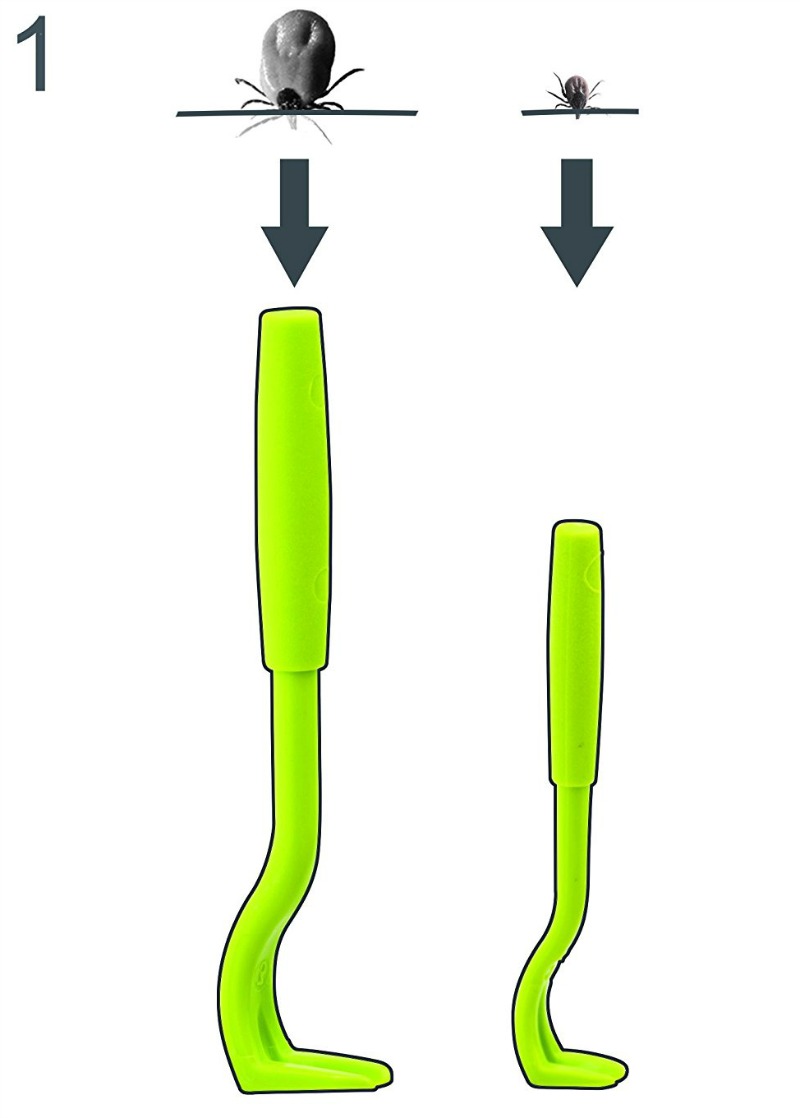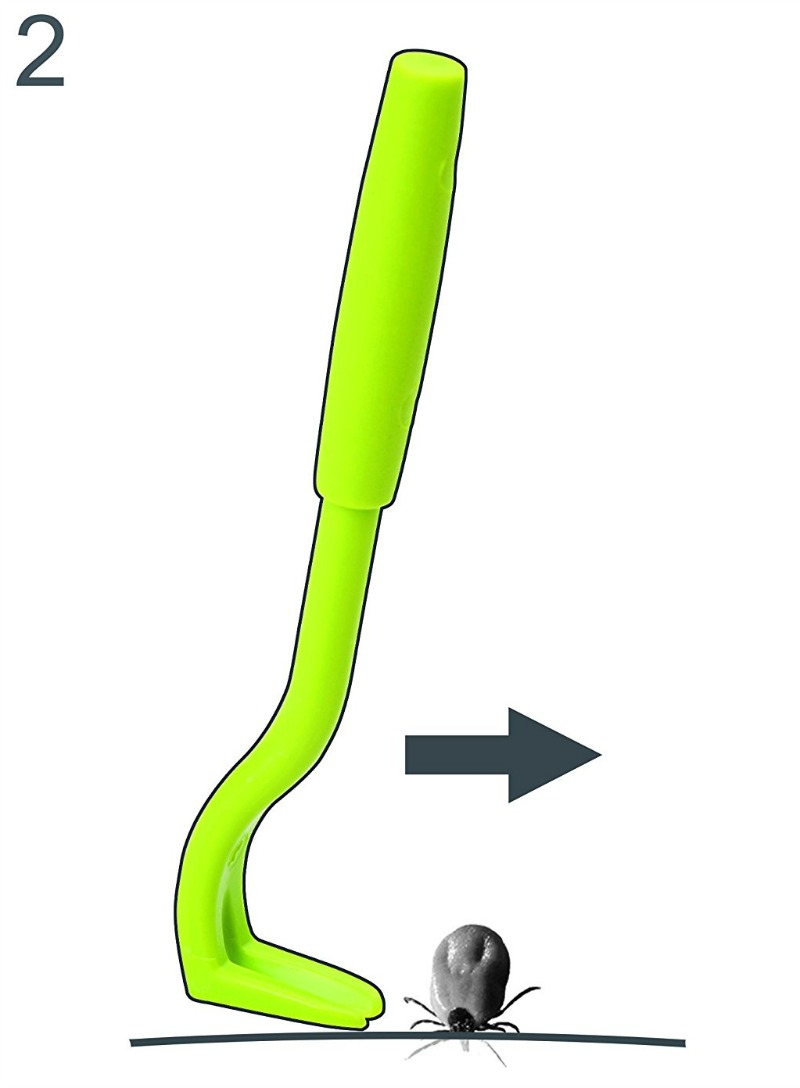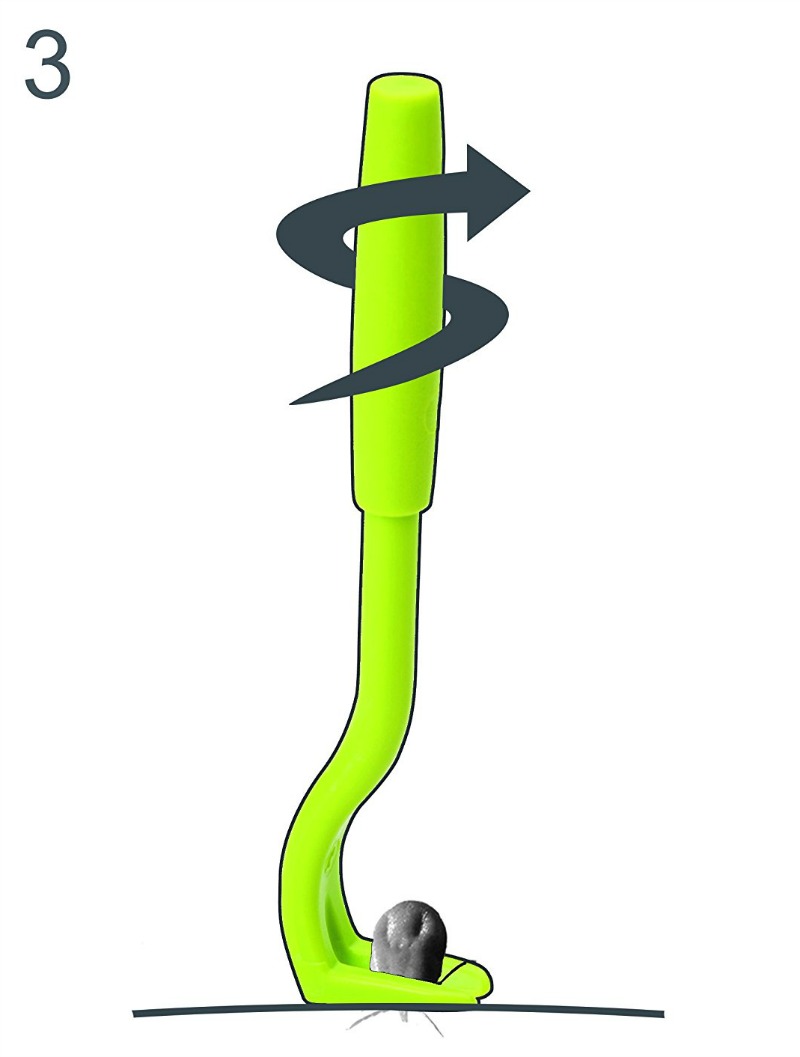Safe method to remove a tick without leaving the head stuck in the skin that works with small or large ticks and is easier than tweezers.

Each spring and summer, warmer weather and spending more time outside and camping outdoors increases the chances of exposure to nasty tick bites. The question is not “if” but “when” it will happen. And, when it inevitably does, how to remove a tick safely to minimize the chances of disease?
I have a friend who lives on a farm in Kentucky with his wife and five children. During tick season, he and his wife perform tick checks every night on all their children right before bathtime. They take ticks very seriously in their home because the Lyme disease carrying kind are very prevalent in their area.
It’s not just Lyme disease that is a potential risk either. The Journal of General Internal Medicine published an article by Susan Wolver, MD, and Diane Sun, MD, which identified a rising trend of red meat allergies from tick bites.
When one of my children was a fairly young baby and not even mobile yet, a tick lodged itself into the top of his head. Most likely, the tick dropped out of a tree onto his head, so don’t think your children are safe just because they aren’t hiking in the woods or walking in the grass!
If you discover that your child or pet has a tick that has lodged itself into the skin, here is the safest, easiest and quickest way to remove it.
How to Remove a Tick Safely and Quickly
The best way to remove ticks is using tweezers according to most authoritative sources. However, there is a new gadget called the tick twister remover that works even better.
My friend in Kentucky says that they used to use tweezers, but the tick twister is far superior and easier to use. It can be used to remove ticks from both pets and people.
Each tick twister tick removal set (it only costs about $6) has two removers inside: one large and one small. The different size is to allow for safe removal of both small and large ticks.
This ingenious device created by a veterinarian to safely remove ticks regardless of a person’s expertise has the following benefits:
- It is easier to use than tweezers especially for small ticks.
- It removes the tick without squeezing it, which greatly reduces the chances of disease transmission.
- It ensures the head and mouthparts of the tick are removed along with the body.
- It can be used for both large and small ticks.
Every home with children and/or pets should have one of these! It should also be included with camping equipment.
Safe Removal Steps. Better than Tweezers!
There are three steps for removing a tick using the tick twister.
First, you select which tick twister to use. If the tick is large, use the larger tick twister. If the tick is small, use the smaller one. Pretty simple!

Second, you grasp the tick between the head and body using the hook end of the tick twister. The picture below shows how to do it.

Third, simply twist the tick twister gently to easily and safely remove the entire tick out of the skin. That’s it!

After removing the tick, thoroughly clean the affected skin with alcohol. If there is any irritation, a dab of this herbal salve does wonders to quickly heal the skin.
Warning About some Tick Removal Recommendations
Some sources recommend pulling a tick straight out of the skin as the best method of removal.
This is very dangerous advice, because trying to pull a tick straight out will almost ALWAYS result in the head staying stuck in the skin. This is because ticks frequently lodge into the skin at an angle. They don’t usually burrow straight in perpendicular to the skin’s surface.
If you must use tweezers because you don’t have the tick twister remover available, be sure to pull the tick out at the same angle it went in.
This will give you the best shot at removing the head along with the body. In other words, grab the tick very firmly and close to the head as you can and pull out on a straight line but the same angle it burrowed in. I hope this makes sense.
It’s a little difficult to describe in words. This is the method taught to me by my Dad, who is a retired family doctor. Using this method, I’ve never left a tick’s head in the skin of any pet or person in over 40 years.
Of course, using the inexpensive tick twister is the best method of all. You don’t have to worry about angles – you simply twist the tick out of the skin!
How to Repel Ticks
This article describes the method for preparing an herbal yarrow tincture which is very effective at repelling ticks so you don’t have to remove them in the first place.
You ideally need to spray yourself every 2 hours or so.
Note that yarrow has been reputedly found by the US Army to be as effective as DEET in repelling ticks.








Hi again Sarah – Again, I too enjoy your blog and think you provide a good service for many people. But this post is just plain dangerous – it’s like suggesting soy formula for babies!
Please respond to all these retraction requests by updating your post and explaining why you continue to feel this method of tick removal is safe, or retracting the story if you feel it is for the best service to your readers.
If you are a “This American Life” NPR radio show follower, you probably have heard the recent retraction of a story they had to do recently, to save their reputation, because they didn’t do their homework. They retracted the story of Mike Daisey, who did a modified-for-radio version of his monologue, “The Agony and Ecstasy of Steve Jobs”, where Daisey told horrifying stories of his visit to the Chinese factories where Apple products are made. At the time, it was the most listened to/downloaded episode in the 15 or so years of This American Life. They found out after the show was aired that Daisey MADE UP SOME OF HIS STORY, mixing fact and fiction (for “theater”) and the producers of TAL failed to do their fact-checking homework. Ira Glass, host of TAL, went on the air to APOLOGIZE to his listeners, something you almost never hear from news folks, even on NPR.
Sarah, please remove this post it is dangerous to promote removing a tick this way. I, like Judith, have loved all of your other posts and the blog. Just wanting to keep people safe and many people comment but don’t read other peoples comments so may not know the above post is wrong. Thanks
I haven’t read the replies above , so someone may already have mentioned the dangers of removing the tick the way mentioned by Sarah.
Sarah, your post on removing a tick is dangerously wrong! That will irritate the tick and it will spew out all it’s nastiness which includes Lyme disease, the fastest spreading vector borne illness the deer tick carries. (The deer tick can carry many more diseases.) Never, ever cover the tick with petroleum jelly or any such thing, because it will do the same thing as above.
Please go to LymeDiseaseAssociation.org for the proper way to remove a tick.
I am hoping, Sarah, that you will take this post down. However, if you do, if there is ANY way to share Judith’s information instead, you will be doing a great service!! I read your post but did not have time to read the comments. My little dog had a tick & I tried the soap… didn’t work. His hair is long so doing it with a tweezers is aggravating to him… I probably should just cut the hair over the tick first (duh….). Anyway, I decided to see if there were comments and — wow. I am very grateful to Judith (and others) for sharing her knowledge.
I heard Vaseline on the tick and the surrounding area. They can’t breathe through their abdomen and are forced to extract themselves.
Kerry, please read the posts that explain why this method is dangerous. Doing anything to the tick besides pulling it off in a safe manner with the right tool will put you in danger. You can check out my posts, and several other people who explained this too, with links.
Gaby Sweningsen, I responded to your question at the blog.
By irritating, suffocating, or in any way bothering the tick, you make it much more likely to transmit disease through regurgitation. The only safe way to remove a tick is to pull it off with fine-pointed tweezers or a similar tool, or one of the new tick tools such as a Tick Key, Ticked Off, etc., grasping it down at the head, and pulling steadily away from the skin. You don’t want to fool with a tick in any way before removing it.
I have posted links from expert health sites that back this up. They say not to irritate the tick and describe the correct method. Please see my comments at your blog, and others’ comments, that explain this. We have posted some excellent links about ticks.
I absolutely love your blog. This is the first post that raised concern, and it is a life or death issue, really. I know of people who died from tick borne diseases, and others who were partially paralyzed and in pain for years. I know of many dogs who died of these infections. Proper tick removal, ASAP, can save a life. This school nurse post has been circulating the internet for years. It is dangerous.
Sarah, please, please read the comments on this at your blog. This is a dangerous practice. Many of us have asked you to retract the post. From a man who studied ticks, and from many Lyme disease sites, the information that is based on tick biology is that if you do anything at all to make the tick detach itself, in the process of detaching, it will regurgitate some of itsk gut contents into the bite wound. This is dangerous because the pathogens stay down in the gut for hours after the tick attaches. It has to feed for several hours before the pathogens move up into the mouthparts and then into the wound.
The tick list has had a lot of discussion about repellants. You could join just to ask about this, although the group is mostly about TBDs in dogs. I posted a link for joining, but here it is again, and it also has a list of excellent links on ticks, tick control, TBDs, etc.:
saluqi.home.netcom.com/ticklinks.htm
It has been having some technical difficulties but should be OK soon.
Personally, I would not put DEET on a child’s skin. I grew up using DEET every time we went in the woods, but I’ve read that it can be toxic, especially to kids. I do sometimes use DEET on my shoes, socks and pants, but not on my skin (my yard is very ticky). I use herbal repellants above the waist. There are some repellants that contain neem oil that work fairly well. Neem by itself is an excellent repellant but stinky. Rose geranium essential oil is supposed to repel ticks specifically. With any herbal repellant, you need to renew it more often than with DEET–every few hours, whenever the odor gets weak, especially if you are sweating. Some folks at the tick list have said that REPEL in the lemon eucalyptus scent works well against ticks. I haven’t tried it yet.
I believe that even herbal repellants carry some low amount of risk for some kids. Essential oils can trigger seizures in dogs if the dog is prone to seizures, though some EOs are more likely to do this than others. I have to assume that there is some danger for kids too, but probably a very low probability. I would use EOs on a child before DEET, personally.
I think you have to try a repellant and see if it works well for you, in your area, if it is an herbal repellant. I once tried a new herbal repellant that was tested and supposedly found to work as well as DEET for ticks (except that it needed renewing more often). I went out into a very ticky area and came back with more than 200 ticks attached–these were newly hatched larval ticks of a species that does not disperse for a while after they hatch. We call them “seed ticks” and it’s easy to get a lot of them all at once if you walk through their little pack. This was within an hour or two of applying a lot of the repellant, and it should have worked. Well, I haven’t used that repellant again! It was based on soy oil and a few herbal oils.
I have made my own, rather stinky neem-based repellant that works very well, but neem oil has a strong smell and is not very pleasant. I could post a recipe here if anyone wants it. It is easy to modify and make a bit less stinky by cutting down on the neem and increasing other essential oils, but it may be less effective that way. The neem-based sprays from the store are not as effective as the home recipe, because they are made to smell nice.
There are clothes available that have been treated with permethrin, which repels and kills biting insects and ticks. I am not clear on permethrin’s safety, so you should read the MSDS sheets, etc. and decide for yourself. But apparently, it’s not absorbed through the skin much at all. Folks at the tick list generally feel that it is safer to use these clothes than to put DEET on the skin. Permethrin is deadly to cats, though–so you may not want to use these clothes or another permethrin product if you have a cat. I think you can get socks, pants, shirts, scarves and hats. One brand is Buzz Off, but there are others. The SierraTradingPost.com site often has these clothes at a big discount. (Great place for hugely discounted outdoor wear. I have no connection to them except as a happy customer.)
There are other things that repel ticks but may not be very pleasant–sulfur powder, for one. I have used it on my shoes, socks and pants. It has a very strong smell but ticks hate it. there are nontoxic yard treatments that may work, if you are only concerned about the yard. I am going to try Mosquito Barrier this summer, which is based on garlic, and claims to get ticks out of the yard along with the skeeters. Sulfur can be used in the yard, also. And I wrote about nematodes for the yard earlier–they are a great option for many areas of the country.
There are many ways to reduce ticks in the yard with landscaping techniques. Some of the tick links at the saluqi link will have information on this. Your local Ag. Extension office should have info too.
Someone at one of my groups, perhaps the tick list, said that a simple spray of apple cider vinegar and water, with some garlic cloves soaked in it for a while, worked to keep ticks off her and her dog in a very ticky area. I can’t vouch for this but I may try it. I would probably grate the garlic and let it soak in the frig overnight or longer.
If I remember anything else, I’ll add it. This is all my personal opinion, based on personal experience. I can’t say what will work for others.
My husband is a forest manager in France and he tells me that with this method there’s a real risk of the tick regurgitating some blood and still passing on disease. Over here they use what looks like a mini crow bar called a ‘tire tique’ which hooks behind the head without putting pressure on the body and then turn the tick clockwise to make it come out with no regurgitation.